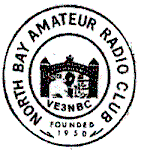SUMMARY: PROVINCIAL SIMULATED EMERGENCY TEST
Primary tabs
NORTH BAY AMATEUR RADIO CLUB
SUMMARY: PROVINCIAL SIMULATED EMERGENCY TEST
OCTOBER 13, 2012
This emergency communications scenario imagined that North Bay and area was hit by a severe winter storm that leaving many homes without power, pipes freezing, our airport closed, and roads almost impassable with the ice and snow.
Thanks to those members who responded and represented the club well today. We fought our way through difficult HF radio conditions today and checked out our capabilities of communicating from various locations with each other using VHF and UHF simplex. All stations ran on 12v power source or handhelds.
PAUL VA3OPP, LORI VE3LOR, MIKE VE3PME, CHRIS VA3CMX, BILL VE3TGI, HOWARD VE3GMG, and myself, DOUG VA3DLJ attended, and were located at Sears, waterfront, Memorial Gardens, Fire Stn.1, OPP Comm. Ctr., ski hill, water treatment plant, university/Canadore area, and the Home Depot lot.
VHF SIMPLEX 146.52, UHF SIMPLEX 446.000, and NFM 147.300 Repeater gave us local interchange. Each operator checked their transmission using each frequency at some point.
VHF ERX 147.030 with the IRLP link via 9036 reflector, allowed us to check in to the rest of the province whenever we needed. We connected with them in Thunder Bay both at the beginning and end of the exercise registering our participation in this province wide event.
HF 80 M 3.745, 40 M 7.153 which were the provincial net frequencies, were used to contact VE3RHJ Brad Provincial Net Control in Markdale. 59 copy was made with Brad during an hour communicating from Memorial Gardens, Waterfront Parking Lot, and the Water Treatment Plant parking Lot. Band conditions dropped out later, and were extremely difficult from the mobiles as the noise floor was sitting in the 9-10+ range at times. 40 m was not used by the Provincial Net Control so we could not verify our connection. However Mike was able to hear several other stations around Ontario and the U.S. Meanwhile 20 m and 15 m had relatively quiet background noise, but of course those stations were out of province. Mike and Paul successfully linked together on 40 m across the city.
We determined a number of ideas during our wrap-up gathering at Tim’s afterward.
1. Base stations with generator power support should be used for HF transmit to the provincial nets.
2. The VHF link worked well, but the person assigned to do the outside connection should be alone and only have a printed or brief oral message passed to them to relay. The IRLP net was found to be full of chatter.
3. Messages going out of the communities were taking up to 5 minutes of provincial airtime each. I would suggest that a review may need to be done at the RAC Canada and provincial levels to see if some abbreviated form of the IMS and NTS form…. It might work alright with CW, but phone consumes far too much time when they expecting to be able to pass thousands of messages in a real event.
4. Our NFM repeater can be successfully used for local interchange to boost the power and range of the simplex transmissions as needed. It also has a generator already supplying power routinely.
5. The UHF simplex was excellent… Paul and Howard began discussions of what would be needed to install a UHF repeater system in one of the locations.
6. When naming stations, we decided that using short names known to us such as clubhouse, alpha, snowball, etc. and that only the central NBARC Command attach the word ‘command’ to the first name for clarity and brevity on the air. This also keeps a level of anonymity to each checkpoint or location. Of course the regular IC assigned call sign would be announced periodically to make this legal for an emergency situation.
7. You can never have enough charged batteries on hand for portables.
8. Use A4 paper.
9. A service to us mobile needs to be available in a real event to bring coffee, radio relief, and other life needs.
10. We should plan to do this at least once a year and involve more members somehow; a great day to check out the capabilities of our equipment and give all a chance to further develop their own abilities.
Thanks everyone!
Doug Johns
VA3DLJ RAC CEC
NBARC Assistant Emergency Coordinator
